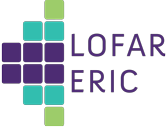Christian Vocks
(Leibniz-Institut für Astrophysik Potsdam (AIP))
We present LOFAR observations of an M class flare, that was accompanied by intense type III radio bursts. Some isolated burst have a fundamental-harmonic structure, but for most bursts this is not visible due to a rapid succession of bursts. Spectroscopic imaging with LOFAR shows type III bursts as a compact source for a given observing frequency. The intensity varies with burst evolution, but the location remains largely fixed since it is determined by where in the solar corona the local plasma frequency matches the observing frequency. But from time to time the source changes its position, with dual structures during the transition. We interpret this as signatures of fundamental and harmonic emission, the latter originating from a higher location in the corona so that the local plasma frequency there matches half of the observing frequency. Fundamental-harmonic pairs, e.g. fundamental emission at 35 MHz and harmonic emission at 70 MHz, should originate from the same plasma volume. Differences in their positions and intensity variations are expected since radio wave transport effects in the corona, like scattering and refraction, should affect fundamental more than harmonic emission. Analyzing such differences therefore allows for quantifying these effects.
Christian Vocks
(Leibniz-Institut für Astrophysik Potsdam (AIP))
Mario Bisi
(RAL Space, United Kingdom)
Bartosz Dąbrowski
(Space RadioDiagnostic Research Centre, University of Warmia and Mazury in Olsztyn, Poland)
Richard Fallows
(RAL Space, United Kingdom Research and Innovation - Science & Technology Facilities Council - Rutherford Appleton Laboratory, Harwell Campus, Oxfordshire, OX11 0QX, UK)
Peter Gallagher
(School of Cosmic Physics, Dublin Institute for Advanced Studies, 31 Fitzwilliam Place, Dublin 2, D02 PN40, Ireland)
Andrzej Krankowski
(Space Radio-Diagnostics Research Centre, University of Warmia and Mazury)
Jasmina Magdalenic
(Center for Mathematical Plasma Astrophysics, KU Leuven, Leuven 3000, Belgium)
Gottfried Mann
(Leibniz-Institut fur Astrophysik Potsdam, An der Sternwarte 16, D-14482 Potsdam, Germany)
Christophe Marque
(Royal Observatory of Belgium, 1180 Ukkel, Brussels, Belgium)
Barbara Matyjasiak
(Space Research Center of the Polish Academy of Sciences, Bartycka 18a, 00-716, Warsaw, Poland)
Diana Morosan
(Department of Physics and Astronomy, University of Turku, 20014, Turku, Finland)
Hanna Rothkaehl
(Space Research Center of the Polish Academy of Sciences, Bartycka 18a, 00-716, Warsaw, Poland)
Pietro Zucca
(ASTRON – The Netherlands Institute for Radio Astronomy, Oude Hoogeveensedijk 4, 7991 PD Dwingeloo, The Netherlands)

